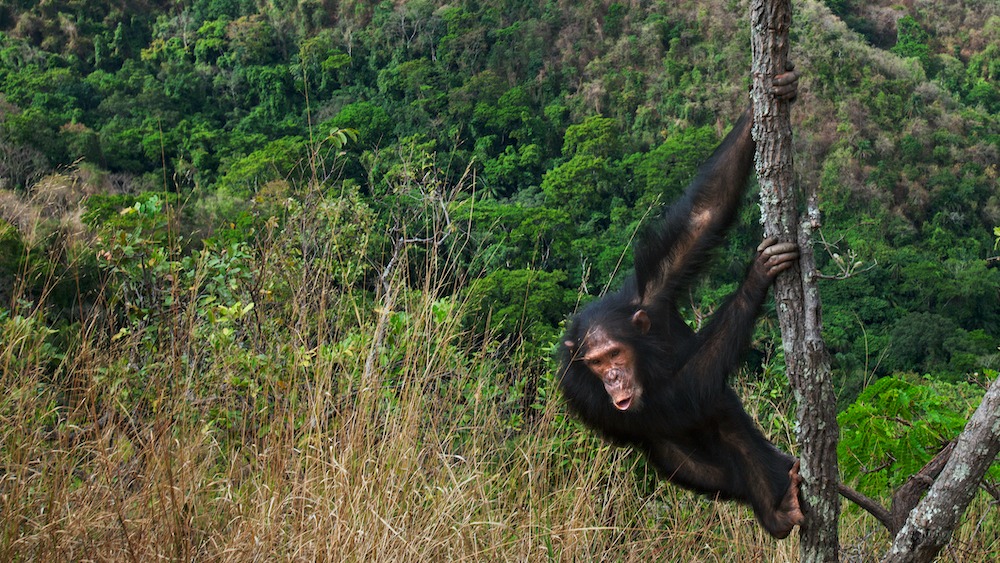Human elbows and shoulders evolved as 'brakes' for climbing ape ancestors
Researchers studied chimpanzee and monkey anatomy to better understand how humans evolved to have flexible shoulders and elbows.

Humans have ape ancestors to thank for their flexible shoulders and elbows, which may have evolved as a natural braking mechanism for tree-scaling.
Scientists made the discovery while watching numerous videos of chimpanzees (Pan troglodytes) and sooty mangabey (Cercocebus atys) monkeys, which are much more distantly related to both chimps and humans, climb up and down trees in the wild.
In the new study, the researchers noticed that although both animals ascended trees similarly with their shoulders and elbows closely bent toward their bodies as they swiftly reached from one branch to the next, they differed in their techniques for descending.
The findings suggest that chimps and humans may have flexible shoulder and elbow joints as a way to "counteract" the effects of gravity on their heavier lower bodies. The result was a finely calibrated braking system that decreased their risk of falling while they descended downward high in the treetops, according to the study, published Sept. 6 in the journal Royal Society Open Science.
While mangabeys were less flexible, the chimps extended their arms above their heads while descending — similar to the way a person goes down a ladder. This maneuver was a way for the primates to slow their descents as gravity pulled them downward, the team said in a statement.
"[We] noticed that while both chimpanzees and mangabeys climbed trees in a clipped motion where they didn't fully extend their joints, in downclimbing the mangabeys continued this clipped motion, while the chimps did not," co-author Mary Joy, a biological anthropology major who graduated from Dartmouth University in 2021 and made this her undergraduate thesis, told Live Science. "The two had very different ranges of motions."
Related: Wild chimps and gorillas can form social bonds that last for decades
Get the world’s most fascinating discoveries delivered straight to your inbox.
Human and chimpanzee ancestors diverged approximately 6 million to 7 million years ago, while the mangabey's monkey ancestor diverged from apes around 30 million years ago.
But the study suggests that flexible appendages had evolved by the time of the last common ancestor between chimps and humans, but after apes and monkeys diverged. This flexibility would have proven beneficial for things that involved specific movements like gathering food, hunting and defending themselves, according to the study.
This marks the first time researchers have extensively studied how great apes descended trees; previously, most studies were focused on them climbing.
"We knew generally that chimps had an increased range of motion in their shoulders and elbows, while mangabeys did not," Joy said.
This is because mangabeys and other monkeys are built similarly to quadrupedal mammals like cats and dogs, which walk on all fours and have "deep, pear-shaped shoulder sockets," the team said in the statement. The inner crook of their elbows also protrudes, making the joint resemble the letter "L," according to the statement. These joints may offer stability, but they lack a good range of motion.
Upon analyzing the joints in existing chimp skeletons that were part of museum collections, researchers noticed that the angle of the apes' shoulders was 14 degrees greater when they were descending versus when they were climbing. Their arms also extended outward at the elbow 34 degrees more when the chimps were going down trees, according to the study.
This change in motion not only helped the chimps slow the pull of gravity but also allowed them to decelerate safely.
"Chimps can get out of trees and climb downward without having to keep their shoulder and elbow muscles under tension, which results in the exertion of a lot of energy," Joy said. "As humans, the introduction of this increased range of motion had a lot of benefits, like letting us raise our arms above our heads or throwing a ball. This motion is a legacy of evolutionary pressure on our ancestors, which gave us the ability to do a lot of things."
Jennifer Nalewicki is former Live Science staff writer and Salt Lake City-based journalist whose work has been featured in The New York Times, Smithsonian Magazine, Scientific American, Popular Mechanics and more. She covers several science topics from planet Earth to paleontology and archaeology to health and culture. Prior to freelancing, Jennifer held an Editor role at Time Inc. Jennifer has a bachelor's degree in Journalism from The University of Texas at Austin.


